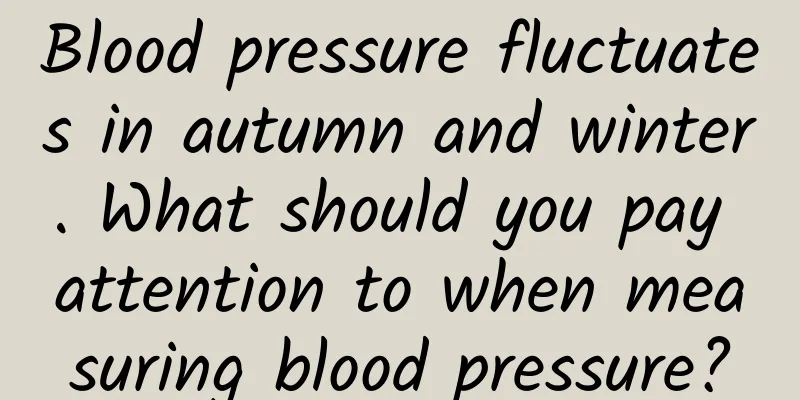Blood pressure fluctuates in autumn and winter. What should you pay attention to when measuring blood pressure?

|
As the weather gets cooler, the temperature difference between morning and evening is large, and blood pressure is prone to fluctuate. As one of the most common chronic diseases, hypertension is often called a silent killer. Early hypertension may have no symptoms, but long-term hypertension can have serious effects on important organs of the human body, such as the heart, brain, and kidneys. Does your blood pressure rise when you get excited in cold weather? How to distinguish true from false hypertension? Do I need to take medicine immediately once the diagnosis is confirmed? Can I still exercise if I have high blood pressure? … 01 Incorrect measurement techniques may lead to false hypertension According to the "China Cardiovascular Health and Disease Report 2021" released by the National Center for Cardiovascular Disease, the number of people with hypertension in my country is about 245 million, and a considerable number of adults are not aware that they have hypertension. "From the perspective of clinical treatment, in the past, most patients with hypertension were elderly people. Now, more and more middle-aged and young patients with hypertension are seen in outpatient clinics. This may be related to our unhealthy lifestyle and high work pressure," said Cha Daogang. For those who are not sure whether they have high blood pressure, experts remind that it is very important to have regular blood pressure checks. Once the blood pressure is found to be above the normal value, the first thing to do is to determine whether it is true high blood pressure or false high blood pressure. Cha Daogang pointed out that false hypertension can be caused by incorrect measurement methods and inaccurate instruments . In clinical practice, we can see that many patients do not master the correct method of measuring blood pressure: For example, when measuring, the blood pressure cuff is tied to the elbow (correct position: the lower edge of the blood pressure cuff is 2 cm away from the elbow, and the cuff is tied so that one finger can be inserted into it); Another example is that the blood pressure monitor used is not accurate (the blood pressure monitor should be calibrated once a year as required); For example, the choice of blood pressure cuff is also particular. Generally, adults have standardized cuffs, but patients who are too thin or too fat should be equipped with a smaller or larger cuff. The appropriate cuff should be selected according to the thickness of the arm. In addition, when measuring blood pressure, you should be careful to do it in a quiet state. If you sit down after an activity outside, you should stay quiet for at least 5-10 minutes before measuring. When standard measurements confirm hypertension, doctors will conduct a graded assessment of the patient's risk of cardiovascular disease based on the degree of blood pressure increase, existing risk factors (such as obesity, smoking, abnormal blood sugar, abnormal blood lipids, family history, etc.), and damage to the heart, brain, kidneys and other organs caused by hypertension. Doctors will then grade the risk into four levels: low risk, moderate risk, high risk and very high risk according to the severity of the disease. Based on this, individualized treatment plans will be developed. 02 Blood pressure measurement at home can be slightly lowered It is worth noting that there is a group of people called "white coat hypertension" in clinical practice. This group of people does not really have high blood pressure, but they are psychologically nervous after going to the hospital clinic, which leads to high blood pressure. If it is simple white coat hypertension, generally no special treatment is required. Another situation is the opposite: the person originally had high blood pressure, but after going to the hospital and seeing the medical staff, he felt reassured and his blood pressure actually dropped. Cha Daogang said that generally from a clinical point of view, without the use of antihypertensive drugs, hypertension can be diagnosed when the systolic blood pressure (i.e. high pressure) is ≥140mmHg (millimeters of mercury) or the diastolic blood pressure (low pressure) is ≥90mmHg (millimeters of mercury) when measured in the clinic three times on different days. Generally speaking, self-measurement of blood pressure at home is more meaningful for the measurement and guidance of hypertension. Residents should also learn to correctly master home blood pressure monitoring. "The standard for home blood pressure can be slightly lower. If the blood pressure measured at home is above 135/85 mmHg, vigilance should be increased." In addition, in order to have a more comprehensive grasp of the blood pressure situation, 24-hour dynamic blood pressure measurement can also be initiated. The patient only needs to wear a special blood pressure monitor, which will automatically collect data at a pre-set frequency during the day and night, so that the doctor can better evaluate the specific individual's condition. 03 It is not necessary to take medicine immediately after diagnosis of high blood pressure It is worth noting that once hypertension is diagnosed, it is not necessarily necessary to take medication immediately. Experts said that after evaluation by a specialist, if the patient is a simple low-risk patient , a 2-3 month observation period can be allowed to see whether the blood pressure can be restored to normal through lifestyle improvements. If the effect is good, the patient can continue to maintain a good lifestyle without taking medication. The observation period for moderate-risk patients should be shortened. If no improvement is found after about a month, drug treatment should be considered. For high-risk and very high-risk patients , lifestyle improvement is necessary, and it is also necessary to start drug treatment as early as possible. If a patient with hypertension comes back for follow-up, it is recommended that they measure their blood pressure once in the morning and evening one week in advance, and provide the record to the doctor as a reference for diagnosis. Hypertension advocates individualized treatment, and each patient has his or her own goal to control blood pressure. For patients with long-term chronic hypertension, they should first pay attention to blood pressure control, secondly, pay attention to drug side effects, and thirdly, whether they have new diseases recently. They should see a specialist or community doctor for regular follow-up. If blood pressure is not well controlled and there are many cardiovascular risk factors, the frequency of follow-up should be shortened, and the doctor should be consulted to re-evaluate the drug treatment plan and adjust the drug in time. 04 When blood pressure reaches the target value, you should exercise regularly To prevent high blood pressure, you should keep in mind the "six steps" of a healthy lifestyle: limit salt intake, lose weight, exercise more, quit smoking and drinking, and keep a calm mind. Among them, limiting sodium salt intake is something that is easily overlooked. Excessive sodium salt intake increases the risk of high blood pressure. Long-term salt restriction can slow the rate at which blood pressure rises with age. The World Health Organization recommends that each person should not consume more than 5 grams of salt per day. Can patients with hypertension exercise? This question is often raised by patients in the clinic. Dr. Cha Daogang said that patients with hypertension can exercise and encourage them to exercise regularly. When the blood pressure of hypertensive patients is under control, they can start healthy exercise after being evaluated by a doctor. "Exercise needs to reach a certain intensity. The general recommendation is (220-age)*60% or 70% of the target heart rate . For example, for a 40-year-old hypertensive youth, his target heart rate should be 108-126, 30 minutes each time, 5-7 times a week. This intensity is suitable for hypertensive patients." |
Recommend
What should you pay attention to before pregnancy
In order to welcome the arrival of the baby, fema...
Precautions after hysteroscopic curettage
Important reminder: Diagnostic curettage with hys...
Urethra pain during late pregnancy
After pregnancy, the fetus grows in the body, the...
Is the ninth day of menstruation a dangerous period?
As we all know, women have a safe menstrual perio...
Are you still worried about acne?
More and more young people are worried about acne...
Why do dentists say that it is not recommended to brush your teeth immediately after eating acidic food! ?
1. Can you brush your teeth immediately after eat...
What to do about amenorrhea caused by anorexia nervosa?
When people deliberately control their diet for a...
Is induced abortion harmful to the body?
With the enrichment of our material life, many yo...
What to do if vaginal opening itches? Combining multiple measures to solve
Some female friends will inexplicably experience ...
Tips for women's health
There are many ways to maintain health, the most ...
Pregnant woman prefers to sleep on the right side, it is a boy
During pregnancy, some pregnant mothers like to s...
Can girls eat crabs during menstruation?
Many girls are prone to abdominal pain after mens...
Basa fish impersonating longli fish was fined 200,000 yuan! How to buy these two fish to avoid being cheated?
The meat is soft and tender, without small bones,...
This heart indicator often appears abnormal, but it may not be a heart disease
Many patients have been shocked by this test resu...
Luotu Technology: China's consumer smart tablet market shipments will reach 28.18 million units in 2023, a year-on-year increase of 1.8%
According to the latest data from Luotu Technolog...









